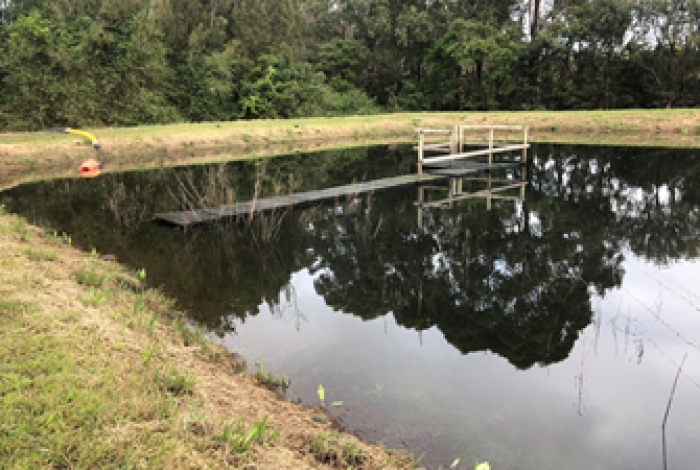Wyong South Sewage Treatment Plant
Central Coast Council is seeking to update its Environmental Protection License (EPL) with the NSW Environment Protection Authority (EPA) to include an additional effluent discharge point at the Wyong South Sewage Treatment Plant in response to increased heavy/extended rainfall.
The Wyong South Sewage Treatment Plant (STP) is located approximately 3km south east of the Wyong Town Centre. Domestic and industrial sewage is pumped into the STP via six receiving pump stations. Sewage is treated at the STP and transferred to the Effluent Disposal Main before being gravity fed to the Norah Head Ocean Outfall.
During times of heavy or extended rainfall excess treated effluent from the Wyong South Sewage Treatment Plant the wet weather pond often exceeds capacity and requires emergency discharge into the environment.
Council is applying to the NSW EPA to add an emergency discharge point and conditions to its EPL licence to enable this discharge to be done in a controlled manner and monitored accordingly.
Have your say
Feedback was to be addressed to the Chief Executive Officer, Mr David Farmer by between 9 March and 5pm 6 April 2023 via:
- the online feedback form (now closed)
- email: ask@centralcoast.nsw.gov.au
- post: PO Box 20, Wyong NSW 2259
Your attention is drawn to the provisions of the Government Information (Public Access) Act 2009 which allows for possible access to certain public and personal documentation. View our privacy statement.
Segmented Documents
Timeline
Who's listening
What is a Sewage Treatment Plant?
Sewage from houses, businesses, educational institutions, commercial complexes, industries needs to be processed to achieve a suitable quality prior to disposal or reuse of water to prevent public health and environmental harm. Sewage treatment plants (STPs) consist of a series of complex processes to remove floating objects and solids, organic matter, bacteria, virus and other substances. STPs are designed to cater for varying flows and contents in the sewage, over the day and throughout the year, to ensure that the treated discharge meets health and environmental requirements.
Mechanical and biological processes are used at sewage treatment plants to separate the solids (sludge) from the water (effluent). Part of the sludge is reused as a soil conditioner in Council’s landscape works while the remainder is disposed of to sanitary landfill. The effluent which has been treated to secondary standard typically contains less than 0.002% solids and is discharged to the ocean via outfalls at Wonga Point, Norah Head and Winney Bay.
What is a Wet Weather Pond?
The Wet Weather Pond is a constructed pond for the storage of treated effluent, the pond is utilised when the treatment plant receives high flows and does not have the pumping capacity to discharge the effluent through to the outfall. The effluent will be stored in the pond until the inflow into the treatment plant has reduced.
Who is the Environmental Protection Authority (EPA)?
The EPA is the environmental regulator within the NSW government responsible for working with business, government, and the community to reduce pollution and waste, protect human health, and prevent degradation of the environment. The EPA issues environment protection licences, requires strict operating conditions and pollution reduction programs, monitors compliance with licence conditions and investigating pollution events, orders the clean-up of pollution and prosecutes or imposes fines to ensure environmental and human health protection. The EPA develops environmental programs and policies, delivers education and awareness programs, and provides technical support and expertise to other government agencies.
What is the Environmental Protection Licence (EPL) and why does Council have one?
An Environmental Protection Licence (EPL) is issued by the EPA for anyone undertaking activities defined in legislation that have the potential to cause pollution. to control the impacts of pollution in NSW. The EPL defines the scale and nature of activities that are permitted, the controls that must be in place to reduce the risk of pollution, and the reporting requirements to the EPA. The holder of each EPL must comply with all conditions of the EPL, develop and update pollution response and management plans, and report monitoring data.
Council holds several EPLs for community services it provides that have the potential to cause pollution. Treatment and disposal of sewage is an activity that requires an EPL.
Why is it necessary for Council to apply to update the EPL?
Holder of an EPL requires an application to vary a premises-based activity licence. A variation includes the substitution, omission or amendment of an existing condition, or attaching a new condition to a licence. These changes include, undertaking a new scheduled activity or ceasing a scheduled activity, removing an activity covered by a licence or adding a new activity to be covered by the licence, changing the scale of an activity, and any other variations.
Council must apply to update an EPL if it changes the scale or nature of its activities that can potentially cause pollution. This includes changes to locations where discharges to the environment will occur.
What are the benefits of the additional discharge point?
An additional discharge point will allow controlled discharge of treated water, to avoid a large uncontrolled volume following major storm events, and to be monitored and controlled in a manner that minimises harm to the environment.
How does the additional discharge point protect the environment?
Discharge can be directed to the creek in a manner that does not impact neighbouring properties, whilst water quality can be monitored in the creek to demonstrate that entry and mixing of the discharged water does not cause environmental harm or risk to public health.
How can I find out more information on the Emergency Discharge Point application?
The community is invited to:
- Read the information available on this page
- Register to attend a virtual drop-in information session to discuss the project with Council staff
